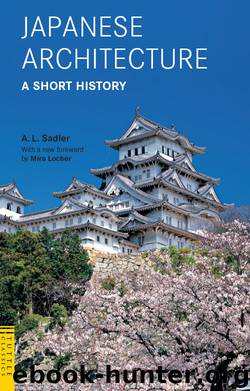Japanese Architecture by A. L. Sadler

Author:A. L. Sadler
Language: eng
Format: epub
ISBN: 9784805310434
Publisher: Tuttle Publishing
CHAPTER 10
Edo Period (1616-1860 A.D.)
THE early part of the Edo era does not differ much in its architecture from the Momoyama period, since those craftsmen and artisans who had worked for the Toyotomis continued to work for the Tokugawas. So things went on without much change till about 1700, when a great deterioration set in. The Tokugawa era was one of complete peace for some two hundred and fifty years, unbroken either by revolt within or assault from without. Few dynasties can have been so fortunate and few have had stronger or abler rulers in the early stages to found and consolidate their administration. For it is a great mistake to think that Ieyasu was the only strong and capable ruler of the line. Actually of the first five Shoguns who carried on the administration until after 1700, i.e. Ieyasu, Hidetada, Iemitsu, Ietsuna, and Tsunayoshi, only the fourth, Ietsuna, was an easy-going character who did not care for ruling, with the result that an energetic and imperious minister, who was a relative, did it for him. The Shoguns had capable men about them and were well served in most things; and naturally the best of the hereditary architect-craftsmen entered their service. Of such a family was Heinai Masanobu who worked on the Nikko shrines in this capacity; his father Yoshimasa had worked on the Kōdaiji and the Toyokuni shrine where Hideyoshi was commemorated, and his grandfather Tameyoshi had built the Imperial Envoy Gate of the Jūraku mansion where he lived.
The work of this period was vigorous enough at first, but gradually everything became stereotyped and conventional, and there was no stimulus from abroad to revive it. After 1700 there was a mere repetition of detail that became weaker and more ornate in both temple and mansion, and only perhaps the Tea Masters preserved a tradition of simple elegance, though even they were by no means unaffected by the general laxity of things.
As time went on the Samurai or military class, who after 1600 or so became an hereditary caste and were forbidden to trade, became poorer and the trading class wealthier and more influential, in spite of the efforts of the government to prevent it by legislation. The result was that the soldier tended to lose his feeling for stern simplicity. Neither Nobunaga nor Hideyoshi had had time to regulate the lives of the people to the same extent as the Tokugawas, and this period is remarkable for its ever-increasing crop of detailed restrictions in the interest of economy and of the proper distinctions to be preserved between the different classes of people. Such economy and distinctions being, of course, for the benefit of the rulers. So from the great Daimyo to the small farmer their way of life came to be prescribed for them by the Gō Roju, the Great Council of the Shogun, and the houses they lived in, as well as the clothes they wore and the food they ate and the toys their children were to be allowed to play with, were carefully specified according to its views.
Download
This site does not store any files on its server. We only index and link to content provided by other sites. Please contact the content providers to delete copyright contents if any and email us, we'll remove relevant links or contents immediately.
| Africa | Americas |
| Arctic & Antarctica | Asia |
| Australia & Oceania | Europe |
| Middle East | Russia |
| United States | World |
| Ancient Civilizations | Military |
| Historical Study & Educational Resources |
The Sympathizer by Viet Thanh Nguyen(4287)
The Rape of Nanking by Iris Chang(4124)
World without end by Ken Follett(3418)
Ants Among Elephants by Sujatha Gidla(3401)
Blood and Sand by Alex Von Tunzelmann(3121)
Japanese Design by Patricia J. Graham(3097)
City of Djinns: a year in Delhi by William Dalrymple(2500)
The Queen of Nothing by Holly Black(2471)
Foreign Devils on the Silk Road: The Search for the Lost Treasures of Central Asia by Peter Hopkirk(2422)
India's Ancient Past by R.S. Sharma(2406)
Inglorious Empire by Shashi Tharoor(2384)
Tokyo by Rob Goss(2381)
In Order to Live: A North Korean Girl's Journey to Freedom by Yeonmi Park(2333)
India's biggest cover-up by Dhar Anuj(2308)
Tokyo Geek's Guide: Manga, Anime, Gaming, Cosplay, Toys, Idols & More - The Ultimate Guide to Japan's Otaku Culture by Simone Gianni(2304)
The Great Game: On Secret Service in High Asia by Peter Hopkirk(2298)
Goodbye Madame Butterfly(2192)
Batik by Rudolf Smend(2112)
Living Silence in Burma by Christina Fink(2028)
